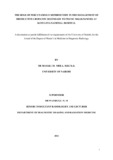| dc.contributor.author | Masaki, M Shila | |
| dc.date.accessioned | 2015-12-21T07:31:48Z | |
| dc.date.available | 2015-12-21T07:31:48Z | |
| dc.date.issued | 2015 | |
| dc.identifier.uri | http://hdl.handle.net/11295/93878 | |
| dc.description | Thesis | en_US |
| dc.description.abstract | 5.1 Background
Ureteric obstruction is an unpromising sign in patients who have advanced malignancy, and
can progress into uraemia and quickly become a terminal event if no intervention is
undertaken. Decompression by percutaneous nephrostomy (PCN) placement provides a
direct access to the urinary tract and allows for drainage of renal tract contents thus
improving renal function and reverse metabolic derangements with presumed low morbidity.
5.2 Objective
The aim of the study is to assess renal function improvement among patients with obstructive
uropathy due to pelvic malignancies after percutaneous nephrostomy placement, by
comparing pre and post procedure levels of urea and creatinine.
5.3 Study setting
Kenyatta National Hospital
5.4 Study design
A descriptive retrospective study
5.5 Methodology
A data collection sheet was used to manually record demographic data, type of pelvic
malignancy, prior radiological imaging, pre drainage by PCN urea and creatinine levels and
10 days post insertion renal function parameters by evaluating the urea/creatinine level from
the records available in the patient’s files, of those who had undergone PCN within the
previous two years from January 2013 to December 2014. The data was entered into an MS
Excel database and analyzed using the Statistical Package for Social Scientists (SPSS™)
version 22. Patients’ longevity was not evaluated, as this was beyond the scope of this study.
5.6 Results
A total of 72 patient files were enrolled into the study. The average age of the study subjects
was 47.4 years (SD =10.3 years). Majority of the study participants were female 70 (97%)
and 2 (3%) were male. The median duration of illness was 8 months; ranging from 2 to 48
months. The most common malignancy was cancer of the cervix (94%) followed by cancer of
the ovary 2 (3%) and cancer of the urinary bladder 2 (3%). The most commonly reported co-
morbidity was hypertension (26%), followed by sero-reactive (24%) and a combination of
hypertension and diabetes mellitus (14%).
Almost all the patients had an ultra-sound investigation (91.7%). None of the patients had
been diagnosed using other tests such as IVU and MRI to diagnose hydronephrosis. The most
common form of therapy that patients recieved was radiotherapy (69%) compared to other
forms of therapy.The median age of the time taken from the radiological diagnosis of
obstructive uropathy to the PCN insertion was 14 days (Range of 1 to 120 days).
Mean creatinine and urea levels, were higher pre PCN compared to post PCN. This difference
was statistically significant. Fifty four (75%) of the patients under went bilateral
nephrostomies and 18 (25%) underwent unilateral nephrostomy. The p values in both groups
approached statistical significance but were slightly more significant in the group who had
bilateral insertions.
5.7 Conclusion
The results of this study show that PCN, though it is expensive is effective as an initial
palliative or temporary means of saving renal function in patients with malignant pelvic
ureteric obstruction. However this will depend on the physician for timely referrals and thus
early intervention. The patient and family need to know and understand the disease, its
complications and the available therapeutic options. | en_US |
| dc.language.iso | en | en_US |
| dc.publisher | University of Nairobi | en_US |
| dc.title | The role of percutaneous nephrostomy in the management of obstructive uropathy secondary to pelvic malignancies at Kenyatta national hospital | en_US |
| dc.type | Thesis | en_US |
| dc.description.department | a
Department of Psychiatry, University of Nairobi, ; bDepartment of Mental Health, School of Medicine,
Moi University, Eldoret, Kenya | |

